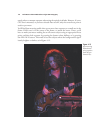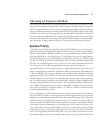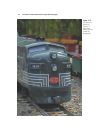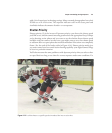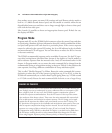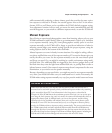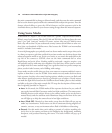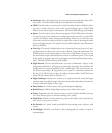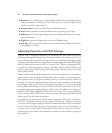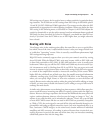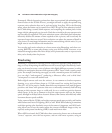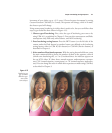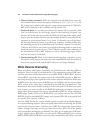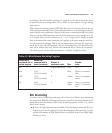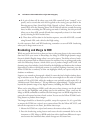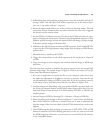
■ Blossom. Uses a small f/stop to expand depth-of-field when shooting landscapes
with broad expanses of blossoms. This Scene mode may result in longer shutter
speeds, so consider using a tripod.
■ Autumn colors. Makes reds and yellows in Fall foliage richer.
■ Food. Boosts saturation to make food look more appetizing in your snaps.
■ Silhouette. Exposes for bright backgrounds, turning foreground objects into under-
exposed silhouettes.
■ High Key. Exposes for bright scenes with lots of highlight areas.
■ Low Key. Tailors exposure for darker scenes, retaining murky shadows while allow-
ing highlights to remain.
Adjusting Exposure with ISO Settings
Another way of adjusting exposures is by changing the ISO sensitivity setting.
Sometimes photographers forget about this option, because the common practice is to
set the ISO once for a particular shooting session (say, at ISO 200 for bright sunlight
outdoors, or ISO 800 when shooting indoors) and then forget about ISO. ISOs higher
than ISO 200 or 400 are seen as “bad” or “necessary evils.” However, changing the ISO
is a valid way of adjusting exposure settings, particularly with the Nikon D7000, which
produces good results at ISO settings that create grainy, unusable pictures with some
other camera models.
Indeed, I find myself using ISO adjustment as a convenient alternate way of adding or
subtracting EV when shooting in Manual mode, and as a quick way of choosing equiv-
alent exposures when in Program or Shutter-priority or Aperture-priority modes. For
example, I’ve selected a Manual exposure with both f/stop and shutter speed suitable
for my image using, say, ISO 200. I can change the exposure in 1/3 stop increments by
holding down the ISO button located on the left side of the camera next to the LCD,
and spinning the main command dial one click at a time. The difference in image qual-
ity/noise at ISO 200 is negligible if I dial in ISO 160 or ISO 125 to reduce exposure a
little, or change to ISO 250 or 320 to increase exposure. I keep my preferred f/stop and
shutter speed, but still adjust the exposure.
Or, perhaps, I am using S mode and the metered exposure at ISO 200 is 1/500th sec-
ond at f/11. If I decide on the spur of the moment I’d rather use 1/500th second at f/8,
I can press the ISO button and spin the main command dial three clicks counterclock-
wise to switch to ISO 100. Of course, it’s a good idea to monitor your ISO changes, so
you don’t end up at ISO 6400 accidentally. An ISO indicator appears in the mono-
chrome control panel and in the viewfinder to remind you what sensitivity setting has
been dialed in.
David Busch’s Nikon D7000 Guide to Digital SLR Photography118



